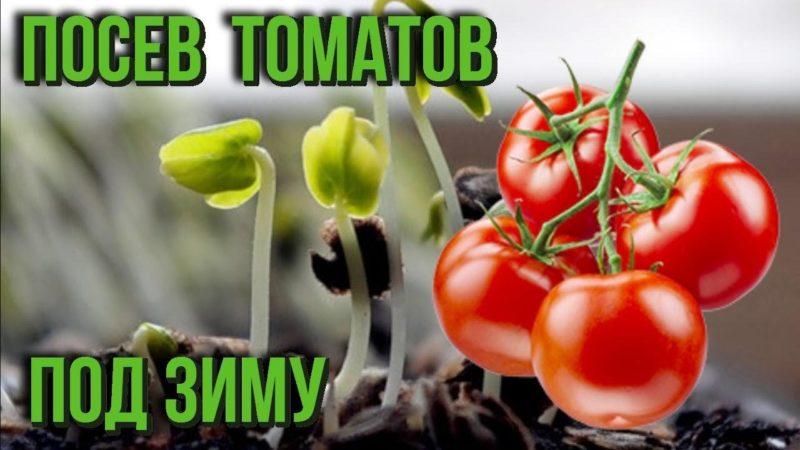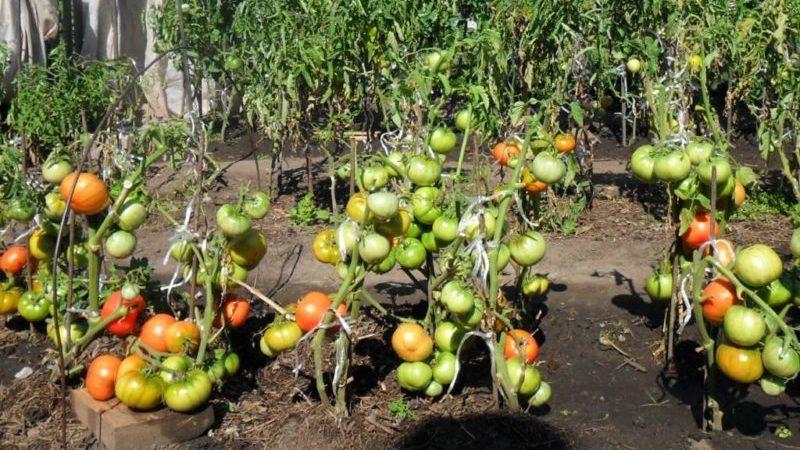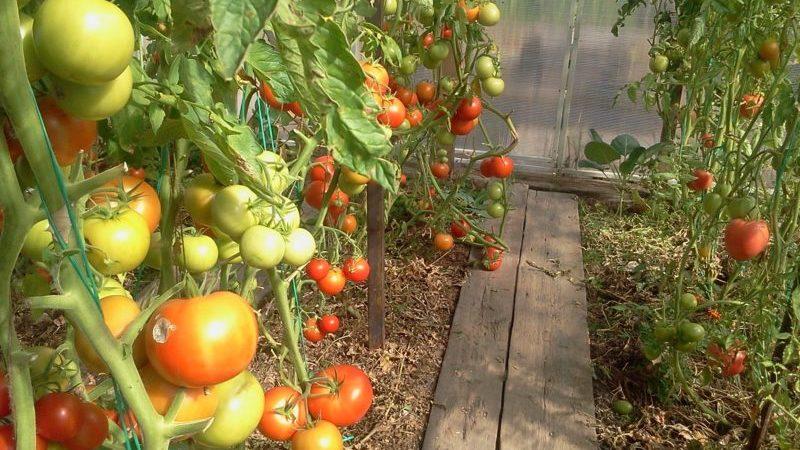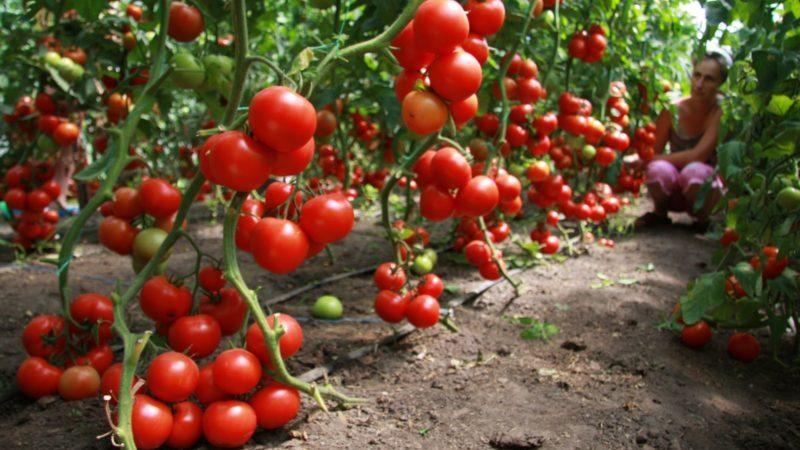How to plant tomatoes before winter
It happens that we sow plants involuntarily - we accidentally drop seeds on the garden bed, and they grow up quite strong and healthy. It would seem that the land is not suitable for a certain varieties plant culture, and the tomato we threw out took and grew. It is noteworthy that the tomato sprouted and began to develop. This means that the plant can be planted with seeds even before winter. The main thing is to properly cover it, and you can wait for seedlings in early spring.
Tomatoes planted before winter grow hardened and have strong immunity. Such seedlings do not lag behind the February and March crops. Plants are very resistant to late blight and tolerate temperature changes normally.
The content of the article
Planting and growing tomatoes before winter: advantages and disadvantages
At first glance, planting tomatoes in cool soil before winter is not the best way, but it will save time in the spring and give a good harvest. Autumn sowing of seedlings does not require special care and diving of the shoots. The culture grows quietly until the time of transplantation to a permanent place.
Seedlings in this case are not required, as well as seeds. Tomatoes are planted entirely and grow their own seedlings in harsh winter conditions. Tomato seeds have a rather high self-preservation instinct.

We do it right:
- until frost approaches, we dig holes with a diameter of no more than 20 cm;
- when the first frost appears, put one whole tomato in each hole;
- we bury tomatoes with earth and trample them down a little;
- fill the hole with dry leaves;
- put an inverted wooden box on top to protect it from the wind.
Until spring, this is where all the manipulations end.
Tomato is a thermophilic plant, but hardening makes it more hardy.
The advantages of planting tomatoes in open ground before winter:
- resistance to diseases, especially late blight;
- ease of grooming: there is no need to prepare nutrient soil and transplant seedlings into a greenhouse or greenhouse;
- the rooting of plantings occurs quickly;
- seedlings are well adapted to temperature changes;
- the plant grows hardened and with strong immunity.
Like any other method of growing crops, the autumn planting of tomatoes has its drawbacks:
- not the fact that all the seeds will sprout;
- some seedlings may become barren flowers;
- the procedure requires compliance with certain rules of agricultural technology for care, albeit in a small amount.
Judging by the fact that sowing tomatoes before winter has more advantages than disadvantages, it makes sense to use this growing method.

Winter sowing methods for tomatoes
Planting tomatoes for the winter involves several basic methods. Although they are similar to each other, there are still certain differences. Let's consider each of them in more detail.
Sowing under straw
A widespread method of planting tomatoes for the winter using straw. In this case, brown spot and root rot are not terrible for tomatoes.
You will need approximately 10 kg of straw per sq. m. The soil is disinfected with a 1% solution of potassium permanganate. At the bottom of the dug holes (15-20 cm deep), we cover overripe straw. Next, we place large and ripe fruits.
Naturally rotten tomatoes are also suitable, but never diseased fruits. Then we put the straw and compost. You can also cover the crops with burlap, agrofibre or spruce branches. We cover the surface of the bed with a layer of straw 12 cm and do not touch it until spring comes.
With the arrival of warm days, we put a mini-greenhouse over the planting. When ready, winter seedlings are transplanted to the place of permanent cultivation. At first, the seedlings lag behind the domestic seedlings in growth, but during the first month the discrepancy decreases.
Note... Most often, crops are covered with straw, because it is more accessible and warmer. Straw saves sprouting seeds and future sprouts better from frost than other materials.

Sowing on compost
In the finished compost pit with the compost made from household organic waste, you need to place the whole ripe tomatoes and sprinkle with earth or cover with branches. During the winter, tomatoes will rot, leaving seed material.
When the snow melts, the seedlings will need to be protected from morning frost with garden agrofibre or film. When the first leaves are formed, the plants need to be temporarily transplanted into a greenhouse or covered with a greenhouse. After they get stronger, they can be planted in open ground.
Such cultivation gives seedlings an advantage: a well-developed root system, a normal perception of negative environmental factors.
Attention! For planting, it is better to use clean materials as material varieties tomatoes, as a hybrid can be disappointing with the result.
Planting whole fruit
The process of planting tomatoes before winter occurs after the first frost. Holes 15-20 cm deep are dug, then one tomato is placed in them. After that, the holes are covered with soil and slightly slammed. The planting is covered with dry earth, and a box with small holes is placed on top. In winter, the box is covered with snow. When the snow melts, the box and leaves are removed.
After emergence, tomato seedlings are protected from low temperatures with a special film. When growing up, the seedlings are transferred to greenhouse conditions. This is how seeds are sown in open ground.
What should be the soil
Tomatoes are planted in open ground before winter in mid-September or early October. This is done at least 14 days before winter sowing.
The earth is dug as deep as possible, by 1 sq. m, one bucket of humus or last year's compost is introduced, as well as fertilizer containing potassium and phosphorus substances, each up to 25 g per 1 sq. m. Further preparation will be carried out depending on the type of landing.
Read also:
Planting tomatoes before winter in a greenhouse or greenhouse
When planting crops before winter in a greenhouse or greenhouse, it is necessary to adhere to certain rules of agricultural technology:
- One of the best planting methods is to plant tomatoes in a line at a distance of 65-75 cm from each other. The width of the beds should not exceed 60 cm.
- It is recommended to place tomato fruits in the holes in a northern direction, starting from the southernmost point of the garden. This method of planting will give the plants more sunlight as they grow.
- Planting is done towards the end of November. In this case, the seeds will not have time to germinate in warm weather.
After the tomatoes have sprouted the first shoots, watering can be carried out. To water culture must be done with the utmost care, try to prevent moisture from getting on the shoots.
Note... To strengthen the immunity of planted plants, sodium humate can be used by dissolving one tablet in 10-12 liters of fresh cold water.
In winter, tomatoes should be watered as needed. There are no special instructions on the regularity and systematic nature of the process, since winters are different everywhere. It is the timely watering that will give the roots the opportunity, absorbing moisture, to strengthen in the ground. Excess water can lead to root rot.
When the temperature in the greenhouse reaches 30 ° C (and this happens around the end of March), the greenhouse will need to be ventilated.
Attention! With sudden changes in temperature, unhardened plants can die. Windows and doors should be opened alternately, gradually decreasing the air temperature in the greenhouse.
The optimum temperature for greenhouse tomatoes is 25 and 10 ° C (day and night, respectively).
Top dressing of tomatoes in greenhouse conditions
When planting tomatoes in the greenhouse in the autumn, after the leaves begin to grow, the crop can be fertilized. The interval of the procedure is 12-14 days. As a top dressing, you can use both organic substances, for example, manure or bird droppings, and mineral additives.

The procedure for feeding tomatoes using the example of bird droppings:
- The contents are diluted in cold water in approximately the following proportion: 0.5 liters of droppings per 10 liters of liquid.
- Plants should be watered in the aisle. The amount of nutrient mixture per 1 sq. m should not exceed 2-2.5 liters.
Experienced farmers do not advise using nitrogen fertilizers for autumn planting of tomatoes due to their low efficiency. Ammonium nitrate for feeding crops is used in early spring.
Mineral fertilizers are applied during the entire period of growth. The substance has many varieties. Instructions for correct use are in the package with the additive.
Let's sum up
Many people are dubious about innovation. Not everyone is able to dare to apply the method of autumn planting of tomatoes. The method of growing tomatoes described by us was discovered relatively recently, but is already successfully used by many farmers and gardeners.
Its effectiveness lies in the unpretentiousness of the process and getting an early harvest. It is worth considering the convenience of this method by analyzing its positive and negative sides. Compliance with all the rules and regulations will help you get a bountiful and early harvest. More information about planting and growing tomatoes for the winter is presented in the video: